
- •Unit 17 Barrier-Free Architecture & Universal Design
- •Installation of wheelchair-ready restrooms
- •Unit 18 Bolshoi Theatre Restoration
- •Circle in the list the words and expressions you know. Write down their translation in the table and calculate the percentage of your lexical competence.
- •Circle in the list the words and expressions you know. Write down their translation in the table and calculate the percentage of your lexical competence.
- •Unit 20 Architecture and Creativity
- •Circle in the list the words and expressions you know. Write down their translation in the table and calculate the percentage of your lexical competence.
- •Inside a Salk Institute's study
Installation of wheelchair-ready restrooms
Forty clean, wheelchair-ready public restrooms are available in downtown Takayama. People in wheelchairs can enjoy movement around the town with comfort, because these restrooms are open to everybody for free. Moreover, many hotels, Japanese inns, and restaurants in Takayama provide wheelchair-ready restrooms.
Signboards at tourist spots
Signboards written in English, Chinese, and Korean are placed at key points along streets to guide tourists walking downtown.
Benches in town
Many benches are provided in the central zone of the town, particularly for allowing the elderly to take refreshing rest after a walk downtown.
Support of means of transportation
Many support-seats or wheelchair-ready taxis are available.
Safety features for blind people
Tactile Braille pathways and Braille markings on bus stops were provided for blind and visually- impaired persons.


Unit 18 Bolshoi Theatre Restoration
1 Introduction2 interface
1.1 Read the text title and hypothesize what the text is about. Write down your hypothesis.
…………………………………………………………………………………………………………………………………………………………………………………………………………………………………………………………………………………………………………………………………………………………………………………………………………………………………………
What do you know concerning this issue? List your ideas in the table left column “I know”.
-
I know that…
I have learnt that…
If you know answers to these questions write them down in the space given after each question.
-
1
When was the Bolshoi Theatre in Moscow inaugurated?
2
Who constructed the present building of the Bolshoi Theater?
3
What were the first years of the project devoted to?
4
How was the problem of providing the theatre with extra working areas solved?
5
What spoiled the unique acoustics of the Bolshoi auditorium?
6
How was each restored element of interior decoration examined?
7
What architectural styles does the Audience hall represent?
Circle in the list the words and expressions you know. Write down their translation in the table and calculate the percentage of your lexical competence.
-
1
to inaugurate
five-tiered
2
to fold up
a wooden pile
3
an overhaul
to subside
4
a constant scrutiny
a backstage area
5
badly dilapidated
an orchestra pit
6
a rehearsal room
forestage
7
a formal reception
a suite of halls
8
an auditorium
a box
T he
Bolshoi Theatre in Moscow has long been seen as one of Russia’s
symbols. Designed by the architect Joseph Bové, it was inaugurated
on 18 January 1825. The Bolshoi Ballet and Bolshoi Opera are amongst
the oldest and most renowned ballet and opera companies in the world.
In fact, the theater is the second largest opera stage in Europe,
only La Scala is larger than Bolshoi.
he
Bolshoi Theatre in Moscow has long been seen as one of Russia’s
symbols. Designed by the architect Joseph Bové, it was inaugurated
on 18 January 1825. The Bolshoi Ballet and Bolshoi Opera are amongst
the oldest and most renowned ballet and opera companies in the world.
In fact, the theater is the second largest opera stage in Europe,
only La Scala is larger than Bolshoi.
Bolshoi Theater’s building represents classical Russian architecture. The neoclassical building impresses with its stature and size, it is considered an architectural masterpiece of Russia. The facade of the building is spectacular with astonishing precision elements and carved statues.
The present building of the Bolshoi Theater was constructed by architect Albert Kavos after the previous building burned down, and opened on August 20, 1856. During World War II, the theatre was damaged by a bomb, but it was immediately repaired. By the 1990s, over 60 per cent of the building was in a very grave condition, having decayed greatly since its last repair works. Time attacked the theater from both construction and decorative perspectives.
I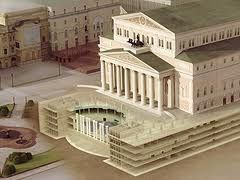 n
2005 when experts first examined the Bolshoi, they discovered that
the building could collapse, fold up like a house of cards at any
moment. Various renovation schemes were suggested: from a superficial
overhaul to a total reconstruction of the existing building. The
project was eventually chosen and approved by the Theatre Company,
architects, public figures in the arts etc. The restoration was to
involve the Theatre’s public spaces and a cardinal reconstruction
of the stagehouse, plus the addition of new, underground space. As a
protected monument, moreover, the building’s historical appearance
had to be preserved. The Theatre’s rehabilitation, therefore, came
under constant scrutiny from state authorities and public alike.
n
2005 when experts first examined the Bolshoi, they discovered that
the building could collapse, fold up like a house of cards at any
moment. Various renovation schemes were suggested: from a superficial
overhaul to a total reconstruction of the existing building. The
project was eventually chosen and approved by the Theatre Company,
architects, public figures in the arts etc. The restoration was to
involve the Theatre’s public spaces and a cardinal reconstruction
of the stagehouse, plus the addition of new, underground space. As a
protected monument, moreover, the building’s historical appearance
had to be preserved. The Theatre’s rehabilitation, therefore, came
under constant scrutiny from state authorities and public alike.
T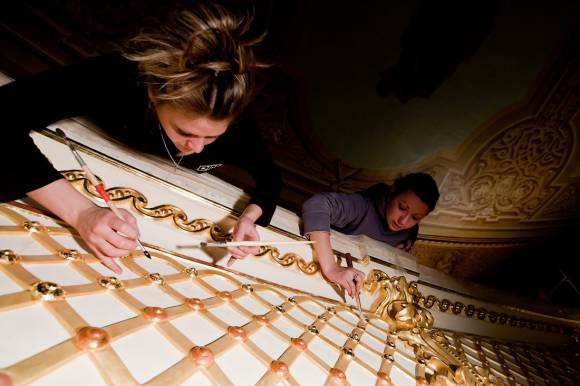 he
reconstruction and refurbishment of the Bolshoi Theatre Main stage
was a colossal, world-level project. The first years of the project
were devoted to a scrupulous examination of the building itself, the
scanning of its position in space, the condition of its walls and
foundations. And only in the autumn of 2009, after numerous
preliminary studies, was the huge and badly dilapidated Bolshoi
Theatre building transferred from temporary supports to a permanent
foundation and large-scale restoration work initiated in the Theatre
itself.
he
reconstruction and refurbishment of the Bolshoi Theatre Main stage
was a colossal, world-level project. The first years of the project
were devoted to a scrupulous examination of the building itself, the
scanning of its position in space, the condition of its walls and
foundations. And only in the autumn of 2009, after numerous
preliminary studies, was the huge and badly dilapidated Bolshoi
Theatre building transferred from temporary supports to a permanent
foundation and large-scale restoration work initiated in the Theatre
itself.
In the two years that followed, record volumes of work were achieved in the renovation and reconstruction of the Theatre. Over three and a half thousand specialists worked at the Theatre each day, of which numbers upwards of a thousand were restorers. And another thousand labored in restoration workshops outside the Theatre.
I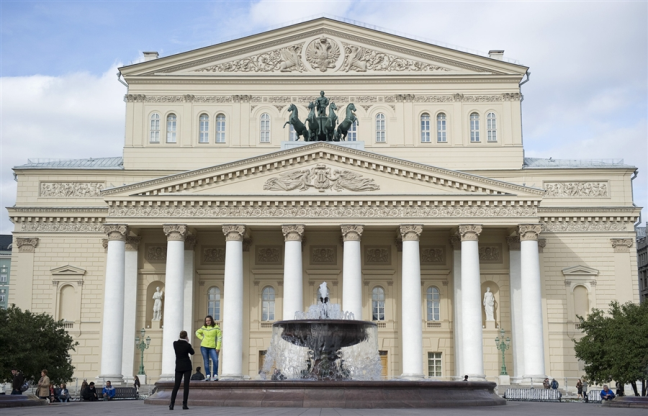 n
addition to the restoration of the Theatre’s historical appearance
both inside and out, the project designers were also faced by the
problem of providing it with extra working areas. This was
successfully solved by the creation of additional underground space.
The theater’s space has been more than doubled to almost 780,000
square feet as the building expanded about 79 feet deep into the
ground. Thanks to the expansion of the Theatre’s existing
underground spaces (under stagehouse) and to the construction of new
underground space under Theatre Square, this has been achieved
without any change to the Theatre’s external appearance.
n
addition to the restoration of the Theatre’s historical appearance
both inside and out, the project designers were also faced by the
problem of providing it with extra working areas. This was
successfully solved by the creation of additional underground space.
The theater’s space has been more than doubled to almost 780,000
square feet as the building expanded about 79 feet deep into the
ground. Thanks to the expansion of the Theatre’s existing
underground spaces (under stagehouse) and to the construction of new
underground space under Theatre Square, this has been achieved
without any change to the Theatre’s external appearance.
Thus the Theatre has acquired badly needed new space, including an underground concert and rehearsal room, which has inherited its name from the Beethoven Hall, under the Theatre lobby. This hall is a multi-functional space which can be used in different ways. It consists of five main platforms: the central platform is the stage itself, two platforms to the right and left of it can be used either to increase the size of the stage or as audience space. The two remaining platforms form the main space of the auditorium. All of the platforms can be raised to foyer level to create a space for holding formal receptions. Apart from this concert hall and its auxiliary premises, the rest of the underground space under Theatre Square accommodates a large number of technical, service and staff rooms.
T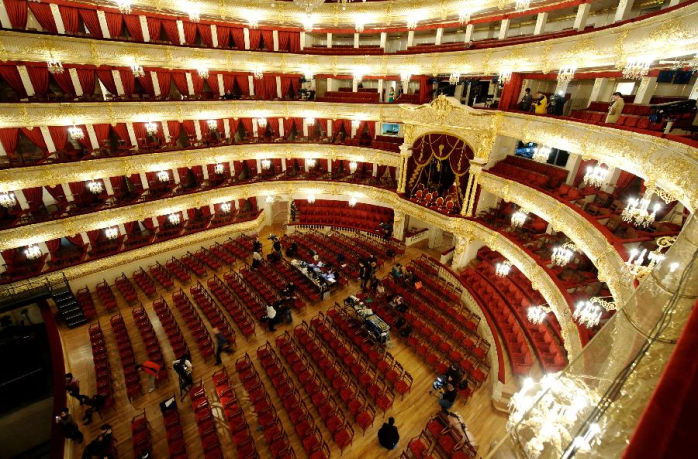 he
five-tiered Bolshoi auditorium was well-known for its acoustics. The
interior was trimmed in wood, and it was said that the theater itself
was a musical instrument – one of the most acoustically perfect
buildings in the world. But even those acoustics have fallen into
disrepair. One of the reasons is the Neglinka River, which eroded the
ground under the theater. After it was enclosed into a pipe and the
ground waters disappeared, the wooden piles of the building’s
foundation started to rot under the influence of air. In 1920, one of
the main hall’s walls subsided during a performance, the doors
jammed, and the audience was evacuated. It forced architect and
engineer Ivan Rerberg, in the late 1920s, to place a concrete plate
under the main auditorium, reminiscent of a mushroom’s shape.
However, the concrete spoiled the acoustics. So, special attention
was paid to the restoration of the legendary acoustics. International
experts did extensive research work and made sure all their technical
recommendations were carried out to the letter.
he
five-tiered Bolshoi auditorium was well-known for its acoustics. The
interior was trimmed in wood, and it was said that the theater itself
was a musical instrument – one of the most acoustically perfect
buildings in the world. But even those acoustics have fallen into
disrepair. One of the reasons is the Neglinka River, which eroded the
ground under the theater. After it was enclosed into a pipe and the
ground waters disappeared, the wooden piles of the building’s
foundation started to rot under the influence of air. In 1920, one of
the main hall’s walls subsided during a performance, the doors
jammed, and the audience was evacuated. It forced architect and
engineer Ivan Rerberg, in the late 1920s, to place a concrete plate
under the main auditorium, reminiscent of a mushroom’s shape.
However, the concrete spoiled the acoustics. So, special attention
was paid to the restoration of the legendary acoustics. International
experts did extensive research work and made sure all their technical
recommendations were carried out to the letter.
State of the art machinery has been installed in the stagehouse. The Bolshoi Theatre Main stage now consists of seven two-tier rising and descending platforms. These platforms can easily change their positions, thus the stage can become horizontal, raked or stepped. The stage and backstage area can be united which creates a stage space of incredible depth. The rehearsal stage mirrors the main stage directly below, so the dancers know the exact size of the space. New upper stage equipment, remotely controlled by computer, makes it possible to derive maximum use from lighting, sound and visual effects. Cutting edge rigs have been installed for the deployment of lanterns, special effects apparatus and acoustics.
The orchestra pit has been provided with extra space under the forestage. This makes it one of the biggest orchestra pits in the world seating up to 130 musicians, which is necessary for the performance of such large-scale works as, for instance, Wagner operas.
T he
Bolshoi has to a large extent reacquired its authentic historical
appearance, lost during the years of the Soviet power. The auditorium
and part of its suite of halls now look as they were originally
conceived by Bolshoi Theatre architect Alberto Cavos. While the
former imperial foyer halls have been given back their 1895 decor,
this was the year they were redecorated for Emperor Nicholas II’s
coronation celebrations. Each reproduced or restored element of
interior decoration was made the object of a special project for
which separate documentation was collected based on numerous archival
and on-site researches.
he
Bolshoi has to a large extent reacquired its authentic historical
appearance, lost during the years of the Soviet power. The auditorium
and part of its suite of halls now look as they were originally
conceived by Bolshoi Theatre architect Alberto Cavos. While the
former imperial foyer halls have been given back their 1895 decor,
this was the year they were redecorated for Emperor Nicholas II’s
coronation celebrations. Each reproduced or restored element of
interior decoration was made the object of a special project for
which separate documentation was collected based on numerous archival
and on-site researches.
The main foyer
I n
2010 the auditorium suite of halls were renovated: the Lobby, the
Main or the White Foyer, the Choral, Exhibition, Round and Beethoven
halls. Muscovites were able to admire the restored facades and the
renovated symbol of the Bolshoi Theatre — the famous Apollo
quadriga, created by the sculptor Peter Klodt.
n
2010 the auditorium suite of halls were renovated: the Lobby, the
Main or the White Foyer, the Choral, Exhibition, Round and Beethoven
halls. Muscovites were able to admire the restored facades and the
renovated symbol of the Bolshoi Theatre — the famous Apollo
quadriga, created by the sculptor Peter Klodt.
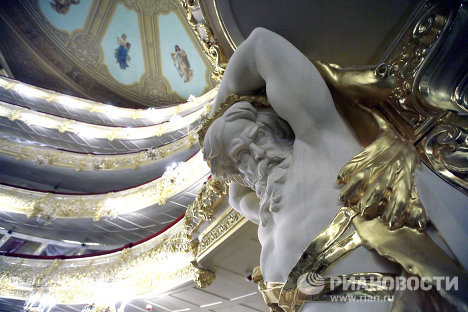
T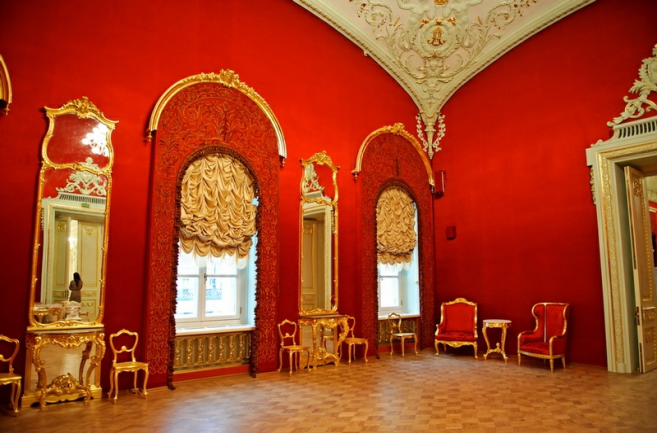 he
Audience hall (auditorium) has regained its original beauty –
brilliancy of the Renaissance mixed with the Byzantine style. And now
each spectator of the Bolshoi Theatre may feel himself just like the
19th century theatergoer; impressed with magnificent and at the same
time “light” décor. The bright crimson, scattered with gold,
draping of the interiors of the boxes, the different on each level
stucco arabesques, the Apollo and the Muses plafond — all this
contributes to the auditorium’s breath-taking impact. On 28 October
2011, the Bolshoi Theatre was re-opened with the ballet and a concert
featuring international artists and opera companies.
he
Audience hall (auditorium) has regained its original beauty –
brilliancy of the Renaissance mixed with the Byzantine style. And now
each spectator of the Bolshoi Theatre may feel himself just like the
19th century theatergoer; impressed with magnificent and at the same
time “light” décor. The bright crimson, scattered with gold,
draping of the interiors of the boxes, the different on each level
stucco arabesques, the Apollo and the Muses plafond — all this
contributes to the auditorium’s breath-taking impact. On 28 October
2011, the Bolshoi Theatre was re-opened with the ballet and a concert
featuring international artists and opera companies.
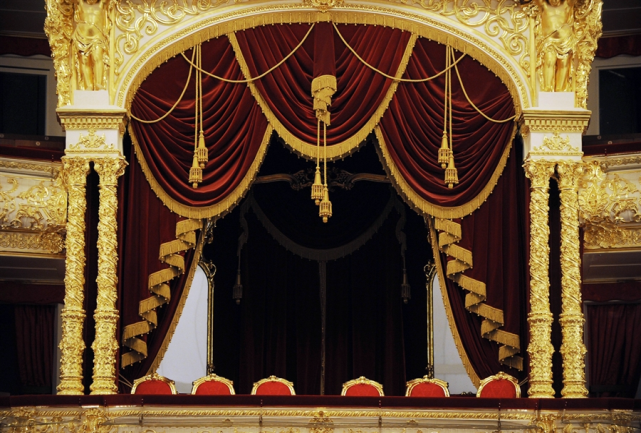
In the 19th century, nobody but the emperor and his suite, The so-called “Czar Box” in the BolshoiTheatre was allowed to be in this hall. It is called the emperor hall.
Unit 19 New Life for Old Constructions
1 Introduction2 interface
1.1 Read the text title and hypothesize what the text is about. Write down your hypothesis.
…………………………………………………………………………………………………………………………………………………………………………………………………………………………………………………………………………………………………………………………………………………………………………………………………………………………………………
What do you know concerning this issue? List your ideas in the table left column “I know”.
-
I know that…
I have learnt that…
If you know answers to these questions write them down in the space given after each question.
-
1
Where is the Webb Bridge located?
2
What is the Webb Bridge fabricated with?
3
What does the bridge look like by day and by night?
4
What is the High Line?
5
Why was the High Line abandoned?
6
Who advocated turning the High Line into an elevated park?
7
The Why is the High Line a great example of sustainability?
